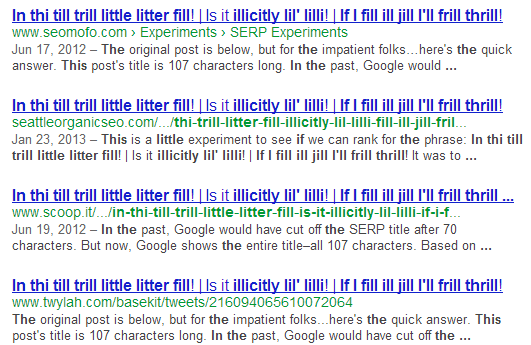
Although the rules of SEO seem to be constantly changing and evolving from one year to the next, there are certain practices that most SEO specialists would argue have generally remained the same over time. For one, optimizing the title tag and meta descriptions on every page of a website has remained a reliable way to improve that page's rankings, making it a necessary and often first step when conducting optimizations. While there is some industry-wide debate about the precise number of characters that should be included in these two fields, no SEO specialist would argue the importance of giving every page unique, compelling title tags and meta descriptions that strategically incorporate targeted keywords. In fact, this technique is one of the most effective tools we have in our metaphorical SEO toolbox.
However, just like so many other once-effective SEO strategies that have since faded away, it seems that “best practices” for traditional title tag and meta description have also come to an end, another victim of Google's whims. While webmasters still can and should enter unique information for these fields across every page on their website, what will ultimately be displayed on Google will be determined by―you guessed it―Google.
Goodbye Character Counts for Title Tags
Gone are the days when the only real constraining factor behind writing a strong title tag was how many characters it comprised. In January of 2013, Google switched from measuring title tags in character count to measuring pixel length—meaning precisely how many horizontal pixels the title tag takes up. As an experiment, type the following phrase into Google: "In thi till trill little litter fill! | Is it illicitly lil’ lilli! | If I fill ill jill I’ll frill thrill!" The SERP shows numerous pages with this exact phrase as their title tags; even though the phrase is 107 characters long. (The commonly recommended length of a title tag is around 70 characters.)

Why is this? Because the phrase consists primarily of characters that take up very little horizontal pixel width – 431 pixels, to be exact.
According to an article in the Webshoptimizer.com blog, the best practice for measuring title tag pixel length is to keep the tag below 469 pixels. In this article, Webshoptimizer has also shared a handy Page Title Pixel Meter counting tool to help you keep your title tags within Google's new width parameters. There are numerous other tools springing up around the web that can be found by a simple search.
Google Now Rearranges Overly-Optimized Title Tags for Brand Names
Another universally agreed-upon tenet of title tag optimization is that the strongest keyword should be placed as close to the beginning of the tag as possible to help the ranking performance of that keyword. As a response, many major companies placed their targeted keyword(s) to the left of their actual brand name on their home page title tag. As an example, here is the title tag for MLB.com:
![]()
But what happens when you actually search for "MLB" on Google?

Google seems to have ignored the title tag specified in the site's code and placed the brand name – the actual phrase that the user was searching for – before the remaining phrase.
Let's try again with another big brand, Ticketmaster. Upon inspecting the site's code, you can clearly see the keywords Ticketmaster is targeting in its title tag:
![]()
However, when you search only for the brand's name, Google renders the site's title differently:

In this case, Google entirely stripped the keywords Ticketmaster included in its title tag and only displayed the name of the brand. Perhaps this is an indication that Google considers Ticketmaster's actual title tag to be a bit too spammy for its liking.
Indeed, if you look in Google's Webmaster Tools help central, Google does give a concise explanation about its new methodology of displaying – or not – displaying certain title tags in its SERP:
"… sometimes even pages with well-formulated, concise, descriptive titles will end up with different titles in our search results to better indicate their relevance to the query. There’s a simple reason for this: the title tag as specified by a webmaster is limited to being static, fixed regardless of the query. Once we know the user’s query, we can often find alternative text from a page that better explains why that result is relevant."—Google Webmaster Tools: Site Title and Description
Google Creating Customized Meta Descriptions Based on Searcher Intent
Another development in Google's aim to provide search results that best match searcher intent is that Google no longer always displays a meta description exactly as it was entered by the webmaster. If there are certain keywords or modifiers used in the search that weren't included in the listing's official meta description, Google will now sometimes take it upon itself to display what it believes to be a "better" meta description that more closely matches what the user was looking for. It does this by pulling from different content areas on the page, assuming these areas have the word the user searched for. Here are some examples:

Upon viewing the page source:
![]()
As you can see, the word "large" never appeared in the actual meta description; but it did appear in the title tag and URL. Therefore, Google rearranged and spliced up the meta description to include all of those sections of the page that included each keyword in our query.
Here is another example:


![]()
As you can see from this tremendously lengthy meta description (327 characters, to be exact!), Google now puts more emphasis on matching each keyword in the query than displaying the actual description provided by the webmaster. Whether or not this meta description is better for user experience is up for debate But, it is important to know that just because you poured hours of hard work into writing perfect meta descriptions, it does not mean that Google will display them.
Takeaways
What do these three major changes have in common? They are all steps Google is taking to achieve its goal of improving the user's experience while using Google, therefore continuing to motivate that person to use Google as his or her preferred search engine. As far as measuring by pixel length is concerned, Google's results now share a uniform width, making the page look cleaner and more organized. And by displaying title tags and meta descriptions that are different than what was specified by the user, Google is leveraging all of the content it has access to to try and best answer the user's query.
What does this mean for SEO? It means that instead of focusing on keyword stuffing and over-optimizing important HTML fields on a given site, you should focus more on providing valuable, informative content written with a variety of helpful and specific words that help make your page provide the most information on the internet for your given industry. Even though it may not seem clear, these adjustments falls exactly in line with all of the algorithm changes Google has made over the past year.



COMMENTS